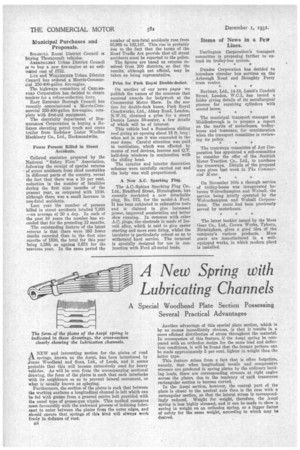A New Spring with Lubricating Channels
Page 42

If you've noticed an error in this article please click here to report it so we can fix it.
A Special AXioodhead Plate Section Possessing Several Practical Advantages
A"
NEW and interesting section for the plates of road springs, known as the Asspi, has Leen introduced by Jonas Woodhead and Sons, Ltd., of Leeds, and it seems probable that this will become extensively used for heavy vehicles. As will be seen from the accompanying sectional drawing, the form of the plates is such that each interlocks with its neighbours so as to prevent lateral movement, or what is usually known as splaying. Furthermore, the section of the plates is such that between the working surfaces a longitudinal channel is left which can be fed with grease from a grooved centre bolt provided with the usual type of grease-gun nipple. This method compares most favourably with the awkward process of inducing lubricant to enter between the plates from the outer edges, and should ensure that springs of this kind will always work freely in defiance of rust.
n8
Another advantage of this special plate section, which is by no means immediately obvious, is that it results in a more efficient distribution of stress throughout the material. In consequence of this feature, if the Asspi spring be compared with an orthodox design for the same load and deflection conditions, it will be found that the former pattern can be made approximately 5 per cent, lighter in weight than the latter type. This feature arises from a fact that is often forgotten, namely, that when longitudinal tensile and compressive stresses are produced in spring plates by the ordinary bending loads, there are corresponding stresses at right angles across the plates, due to the tendency of each transverse rectangular section to become curved. In the Asspi section, however, the central part of the plate is closer to the neutral axis than is the case with a rectangular section, so that the lateral stress is correspondingly reduced. Weight for weight, therefore, the Asspi spring is less highly stressed, and it can be made to show a saving in weight on an orthodox spring, or a bigger factor of safety for the same weight, according to which may be desired.
























































































